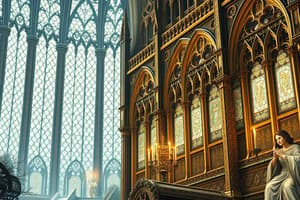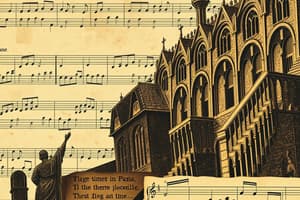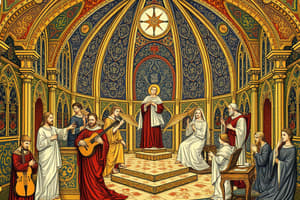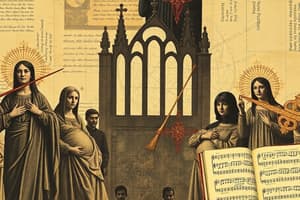Podcast
Questions and Answers
What is the primary characteristic of Gregorian chant?
What is the primary characteristic of Gregorian chant?
- It is performed with instrumental accompaniment.
- It includes multiple melodies sung simultaneously.
- It is a polyphonic vocal piece.
- It consists of a monophonic vocal line. (correct)
Who is recognized as the 'last of the Trouveres'?
Who is recognized as the 'last of the Trouveres'?
- A troubadour from Southern France
- Pope St. Gregory the Great
- Adam de la Halle (correct)
- Guido d'Arezzo
Which themes were predominantly found in troubadour music?
Which themes were predominantly found in troubadour music?
- Science, mathematics, and philosophy
- Nature, environment, and travel
- Politics, economics, and agriculture
- War, chivalry, and love (correct)
What significant contribution to music theory did Guido d'Arezzo make?
What significant contribution to music theory did Guido d'Arezzo make?
What does the term 'a cappella' refer to in music?
What does the term 'a cappella' refer to in music?
What marked the beginning of the Renaissance period in music?
What marked the beginning of the Renaissance period in music?
Which musical form was innovatively developed during the Renaissance for church services?
Which musical form was innovatively developed during the Renaissance for church services?
Which city is recognized as the birthplace of the Italian Renaissance?
Which city is recognized as the birthplace of the Italian Renaissance?
What does the term 'Mass' mean in the context of Catholic services?
What does the term 'Mass' mean in the context of Catholic services?
Which of the following is NOT a type of Mass mentioned?
Which of the following is NOT a type of Mass mentioned?
Thomas Marley is known as the 'Father of Madrigal' for his contributions to which genre?
Thomas Marley is known as the 'Father of Madrigal' for his contributions to which genre?
Baroque music is characterized by which of the following features?
Baroque music is characterized by which of the following features?
What is a 'Concerto Grosso'?
What is a 'Concerto Grosso'?
Which composer is primarily known for innovations in polyphony and church music during the 16th century?
Which composer is primarily known for innovations in polyphony and church music during the 16th century?
What distinguishes an oratorio from an opera?
What distinguishes an oratorio from an opera?
What was a common reason for Johann Sebastian Bach to compose music?
What was a common reason for Johann Sebastian Bach to compose music?
Flashcards are hidden until you start studying
Study Notes
Medieval Music (700-1400)
- Medieval period marked the beginning of written music, with both secular and religious applications.
- Music often consisted of prayers chanted in various forms.
Gregorian Chant
- Framework established by combining Catholic, Gallican, and Roman chants, also known as plainchant or plainsong.
- Monophonic vocal line typically sung by monks; major form of choral music of the period.
- Named after Pope St. Gregory the Great.
Troubadours’ Music
- Troubadours were traveling aristocratic poet-musicians from Southern France, known for their impactful melodies and poetry.
- Themes focused on war, chivalry, and love; notable songs include narratives about King Arthur.
Medieval Music Composers
- Adam de la Halle (Adam Le Boscu) recognized as the last Trouvere; contributed to both monophonic and polyphonic music in the 13th century.
- Educated at the University of Paris; combined songs, dances, and instrumental melodies.
- His work “Jeu de Robin et Marion” is considered the first opera.
- Guido d’Arezzo, an Italian monk, introduced the solmization system (do-re-mi) in the 10th century, using hymn initials for note names.
Renaissance Music (1400-1600)
- Renaissance signifies "rebirth," marking a period of growth in music and other cultural aspects influenced by Greek and Roman literature.
- Emphasis on Humanism emerged during this era.
Musical Styles
- A cappella refers to vocal music performed without instrumental accompaniment.
- Polyphony features multiple melodies sung or played simultaneously.
- Birthplace of Italian Renaissance is Florence, which saw major developments in monody and early opera.
Music Forms
- Mass: Composed for liturgical purposes with two varieties: Ordinary Mass (fixed prayers) and Proper Mass (variable prayers).
- Madrigal: Evolved from troubadour music, focused on secular poetry, characterized by sentiment and charm, mostly polyphonic in structure.
Renaissance Music Composers
- Giovanni de Palestrina was a key figure in 16th-century Roman School music, influential in church polyphony.
- Thomas Morley, known as the "Father of Madrigal," wrote songs with themes of comedy and infatuation.
Baroque Music (1600-1750)
- Derived from the Portuguese "boracco," meaning oddly shaped pearl; aimed to evoke emotion through contrasting dynamics and tempo.
- Foundation for modern music writing, leading to various compositional innovations.
Music Forms
- Concerto Grosso: Ensemble work featuring a group of soloists (concertino) and full orchestra (ripieno).
- Fugue: Composition built on a single musical idea with interwoven melodies, sung or played by multiple performers at different times.
- Oratorio: Large-scale sacred work for soloists, choir, and orchestra, focusing on religious themes; contrasts with opera which often addresses secular topics.
- Recitative: Sing-talk style that retains musical melody while conveying text.
- Chorale: Melodic hymn sung congregationally in German Protestant services, often in a four-part setting.
Greatest Baroque Composers
- Johann Sebastian Bach: Early violinist and harpsichord player, composed works to combat insomnia.
- George Frederic Handel: Known as “The Great Bear” for his imposing presence and demeanor.
Studying That Suits You
Use AI to generate personalized quizzes and flashcards to suit your learning preferences.




